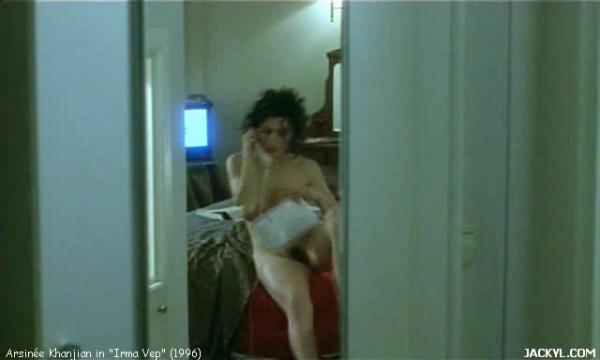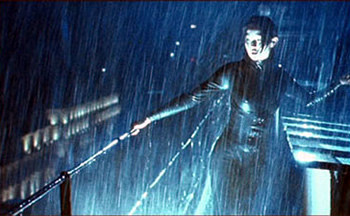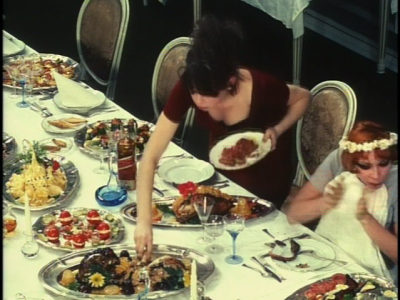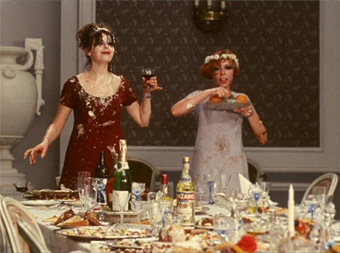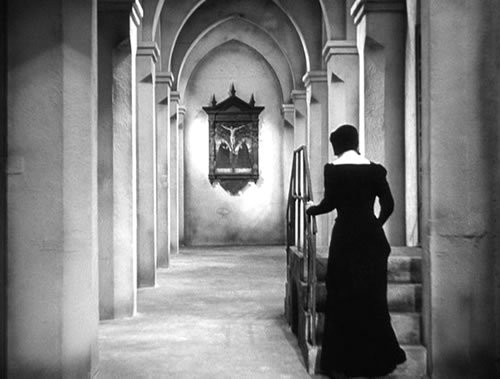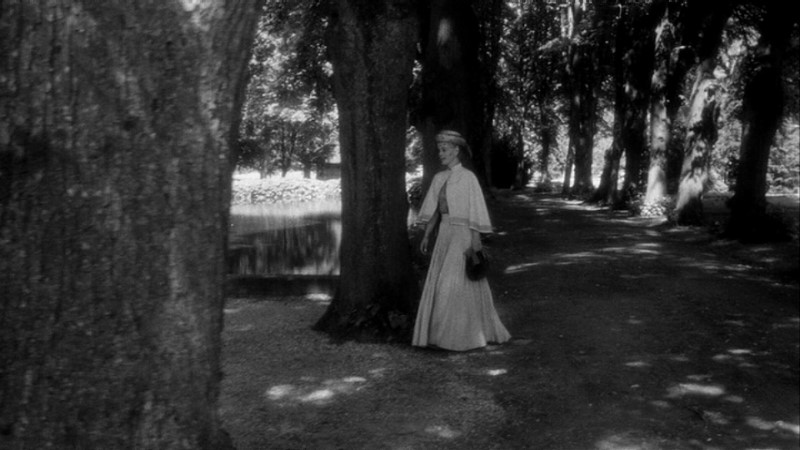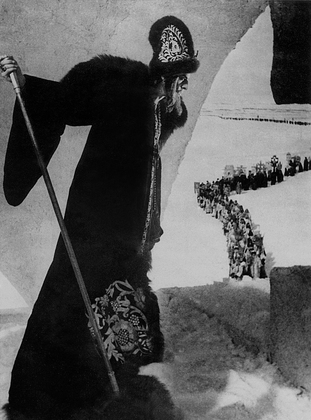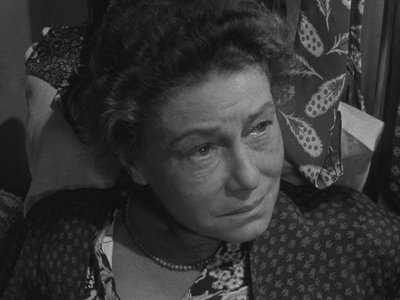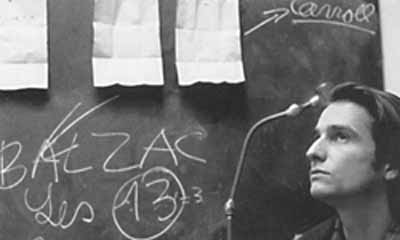Here are ten of the 40-odd short pieces I wrote for Chris Fujiwara’s excellent, 800-page volume Defining Moments in Movies (London: Cassell, 2007). — J.R.
Scene
1996 / Irma Vep – Maggie Cheung stealing Arsinée Khanjian’s jewels
France (Daica Films). Director: Olivier Assayas. Cast: Maggie Cheung, Arsinée Khanjian.
Why It’s Key: If a movie can be said to have an unconscious, here’s where this one’s secret is buried.
Costumed in a tight black latex suit, Maggie Cheung, playing herself, is in Paris to play the title role in a remake of Louis Feuillade’s 1916 crime serial, Les vampires. She also seems to be the object of the sexual fantasies of everyone working on the film —- most noticeably the director (Jean-Pierre Léaud) and the woman handling costumes (Nathalie Richard).
After what seems like a restless, sleepless evening in her hotel room, Cheung goes out into the hallway, still in her suit, stealthily climbs the stairs, and, after spying a maid delivering a tray to a room and leaving, sneaks into the room herself. Still hidden, she sees a nude woman (Khanjian, wife and lead actress of Atom Egoyan) describing her lonely boredom on the phone to someone named Fred, then glimpses the woman’s jewels in another room, which she promptly steals. Running to a fire escape and climbing to the roof in a driving rain, she briefly fondles the jewels, then tosses them down to the street in slow-motion.
When we see Maggie next, she’s being woken in her room, still in costume. Then we see her body double film a take where Irma climbs to a roof. We never learn whether Maggie’s theft was a dream or a real act performed as a kind of rehearsal. Khanjian is another kind of body double, her nudity implicitly replacing Cheung’s in our own sexual fantasies. Both women are plainly bored and lonely, looking for excitement, and so are we.
***
Scene
1966 / Daisies – The food orgy.
Czechoslovakia (Ceskoslovenský Státní Film/Filmové Studio Barrandov). Director: Vera Chytilová. Cast: Jitka Cerhová, Ivana Karbanová. Original title: Sedmikrasky.
Why It’s Key: The climactic shock in this avant-garde farce is connected to food, not sex.
In an avant-garde feminist farce full of giggles and outrages, the ultimate jolt, which reportedly got its director into the most trouble, is an extravagant food orgy. Prior to this, the countless antics of two 17-year-old girls, both named Marie, nearly all involve food and/or drink, some of it served in posh restaurants, as well as the promise of sexual favors to dirty old men that are never delivered. Sometimes the transgressions are mainly formal; sometimes they involve both food and sex, such as when phallic bananas are compulsively sliced.
Eventually, the heroines’ plotless wanderings bring them via a dumbwaiter to a huge banquet hall filled with delicacies. After tentatively sampling a few dishes, they start sinking their hands into the sauces, devouring chickens, swilling diverse kinds of liquor, mixing together different dishes, gorging on pastries, and finally engaging in a food fight worthy of Laurel and Hardy —- much of this done to the strains of the Austrian national anthem. Then they start dancing on the table, swinging from an ornate chandelier, and smashing plates and glasses. Finally, to make matters even worse, they pretend to clean up the carnage —-reassembling plates like jigsaw puzzles and scraping food off the floor to heap it back onto trays.
Indignant Czech citizens who decried the waste and self-indulgence were only rising to the bait. The film ends with newsreel shots of aerial bombardment, over which a title appears: “This film is dedicated to those whose only reason for outrage is mutilated lettuce.”
***
Scene
1988 / Distant Voices, Still Lives – Sequence in a movie theater (to the strains of `Love is a Many Splendored Thing’).
United Kingdom (British Film Institute/Channel Four Films).
Director: Terence Davies. Cast: Angela Walsh, Lorraine Ashbourne, Vincent Maguire.
Why It’s Key: Davies regards moviegoing as a religious experience, and this scene’s an epiphany.
This scene is far from being the only epiphany in Terence Davies’ work, or even the only one tied autobiographically to his childhood in Liverpool and to his experience of movies. (There’s another one in The Long Day Closes, synchronized to the theme song of Tammy and the Bachelor.) But this is only one set at a movie theater, and Davies starts it off with an image he’s described as an hommage to Singin’ in the Rain: raindrops splashing on a sea of black umbrellas, then a slow crane upwards to one-sheet posters for Love is a Many Splendored Thing and Guys and Dolls. Cut to a slow camera movement left and forward, through an auditorium’s crowd of spectators spotted by wisps of cigarette smoke, to the figures of Eileen (Angela Walsh) and Maisie (Lorraine Ashborne), both sobbing their eyes out in response to what they’re watching, none of which we see.
It’s a stirring indication of the emotional catharsis that movies can bring, Davies’ movies included. And then he concludes with one of those irrational yet powerful moments that only he can come up with: over the final strains of “Love is a Many Splendored Thing,” a diptych uncannily shows us the character George (Vincent Macguire) falling from a height through a glass skylight in two separate takes at once. It’s a tribute to Davies’ genius that he can make such an anomalous dovetailing of cinematic ecstasy into industrial accident seem like the most logical thing in the world.
***
Scene
1932 / Ivan – An old peasant proudly refusing to work.
Soviet Union (Ukrainfilm). Director: Alexander Dovzhenko.
Cast: Stepan Shkurat.
Why It’s Key: In a film exalting collective work, here’s an appreciation of an old coot who refuses to join in.
The standard Western line on postrevolutionary Soviet cinema is that it’s politically correct to a faulr. But considering the trouble Ukrainian master Alexander Dovzhenko got himself into —- especially with Earth and Ivan, two of his greatest works —- this cliché has to be revised. The latter, his first sound film, celebrates the construction of a huge dam on the Dnieper River that we never see in any finished state. One of the three characters in the film named Ivan has an illiterate father named Stepan Iosovich Guba, a peasant who unapologetically refuses to join in the work and laughs derisively at those who do.
He’s first seen grasping and sniffing a daisy while scoffing at the very notion of going to work; his gutteral, diabolical laughter almost makes him seem like a predatory animal. But he’s the comic relief, a little bit like Walter Brennan’s Stumpy in Rio Bravo, and it’s clear that Dovzhenko can’t get enough of him, even after his son denounces him at a public meeting and he proudly replies, “I am a unique individual.”
While countless others are viewed from heroic low angles working on the dam construction, we see him fishing, framed at eye-level. Nearly all his appearances in the film are hilarious solo performances, including the scene when he picks up his paycheck. At a key moment, he shows the camera first his profile, then the back of his neck before proceeding to ridicule his comrades by marching around in stiff formation. In short, he’s irresistible.
***
Scene
1943 / Day of Wrath – Anne walking while the camera, panning away from her, also tracks after her.
Denmark (Palladium Productions). Director: Carl Dreyer.
Cast: Lisbeth Movin. Original title: Vredens dag.
Why it’s Key: Dreyer uses a camera movement he invented to express a complex, conflicted emotion.
The time and place are Denmark in 1623, when people still believed in witches —- or Denmark in 1943, during the height of the Nazi occupation, when Jews were being deported and Carl Dreyer was shooting this masterpiece. Although he later disavowed any intention of commenting on the present, it’s difficult to avoid the parallels whereby apparent demons are identified, tracked down, captured, and finally burned.
Anne (Lisbeth Movin), the sexy young heroine, married to pastor who’s much older than her, is walking across the rectory to the room where an old woman who’s accused of being a witch is being interrogated by her husband. Anne’s own mother was burned as a witch, and it would appear that she’s both attracted to and repelled by the notion that she might actually be a witch herself — a notion she eventually comes to believe by the film’s conclusion. Whether this is a film about repression and paranoia or one about how witches are produced, it solicits our identification as well as our detachment.
Dreyer invented a very sensual form of camera movement in which the camera glides on unseen tracks in one direction while it pans in another direction. It’s this complex and hypnotic movement that accompanies Anne as she crosses the rectory, drawn forward and then momentarily retreating, burning with fear as well as curiosity as the camera, moving both towards and away from her, conveys her passionate ambivalence. And the melodramatic music that follows her passage starkly conveys the same principle of attraction-repulsion.
***
Scene
1964 / Gertrud – Gertrud meets her lover in a park.
Denmark (Palladium Productions). Director: Carl Dreyer.
Cast: Nina Pens Rode, Baard Owe.
Why It’s Key: It’s only the second scene in a film about love, and Dreyer expresses in a single cut everything we need to know about passion.
“She awoke at last to find herself getting laid; she’d come in on a sexual crescendo in progress, like a cut to a scene where the camera’s already moving.” Curiously, this sentence by Thomas Pynchon in The Crying of Lot 49 (1966) comes only two years after the release of Carl Dreyer’s final feature. This isn’t to suggest any influence — only a striking congruence with a cut to a scene where the camera’s already moving as it follows Gertrud’s determined stride across a park to keep her rendezvous with Erland Jansson, the much younger composer she’s fallen in love with. In the previous scene — ponderously paced, in a claustrophobic flat — she has just told her stuffy middle-aged husband Gustav at some length that she no longer loves him and is leaving him. And Dreyer’s sudden cut in media res to her moving towards Erland expresses infatuation and orgasmic passion like few other camera movements in cinema — as if to replicate both her impatience and her ecstatic anticipation. The startling wrench of the cut is accentuated by a plaintive phrase played by a flute in the score that lasts only as long as her steps, the first music we hear after the film’s credits.
They meet at a bench beside a placid pond that seems to glisten with Gertrud’s happy rapture. Much later in the film, when Erland breaks her heart in the same setting, the same pond is ruffled by quiet turbulence, but here it shines with joy.
***
Scene
1945 / Ivan the Terrible, Part I – Ivan readjusting his posture with his scepter to create a remarkable angular composition.
Russia (Alma Ata Studio) Director: Sergei M. Eisenstein.
Cast: Nikolai Cherkasov. Original title: Ivan Grozny I
Why It’s Key: The master of Russian cinema subjugates the former ruler of Russia and the Russian people.
In the final sequence of the first part of Sergei M. Eisenstein’s Ivan the Terrible —- a monstrous, angular masterpiece that can be seen simultaneously as a blistering and remarkably courageous parody of Josef Stalin, an apologia for the same demamgogue, a troubled self-portrait, and the greatest Flash Gordon serial ever made —- the title hero has just abdicated his throne and gone to live in a monastery. An endless procession of people is seen approaching from a distance to persuade him to return to power, and Ivan goes out to see them —- not to greet them, for he’s plainly too godlike for that, but at least to take note of them. He strikes a series of almost mystical poses in which he appears to be both listening and brooding while the zig-zag shape of his arm and scepter uncannily “rhymes” with the snaking line of the distant crowd behind him.
As Russian historian Joan Neuberger notes, this scene is one of several showing us how Eisenstein’s view of the masses, the heroes of his silent classics Potemkin and October, has darkened considerably so that they now seem to yearn for subjugation rather than freedom. “The magnificent shot compositions of the finale emphasize the enormous power of the tsar and the minuscule insignificance of the people….He becomes a detached, impersonal, symbolic figure, an abstraction, the embodiment of the Great Russian State.” And paradoxically, Eisenstein is tyrannically twisting the shapes of both Nikolai Cherkasov and the crowd into mirroring pretzels in order to make his point.
***
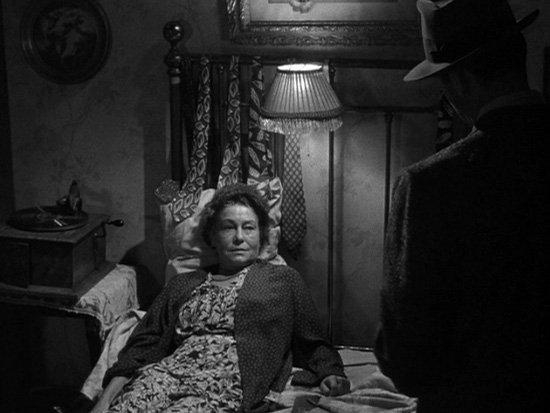
Speech
1953 / Pickup on South Street – Moe’s deathbed monologue.
U.S.A. (20th Century-Fox). Director: Samuel Fuller. Cast: Thelma Ritter, Richard Kiley.
Why It’s Key: An tired old stool-pigeon sacrifices her life in order to defy the Commies, and breaks our heart.
Thelma Ritter got an Oscar nomination for her supporting role as Moe, a police informer who sells neckties as a front. This is the only time Samuel Fuller’s unfashionable working-class cinema has ever been honored in such a fashion. Fuller had a special feeling for feisty old ladies — most of whom seem to be based to varying degrees on his mother — and none of these is more memorable than Ritter. A figure of some pathos, she only cares about making enough money to be buried in a decent cemetery.
The curious thing about Moe is that Skip (Richard Widmark) — the closest thing this movie has to a hero, and he’s an unapologetic pickpocket —- doesn’t resent her at all because he reasons she’s just making a living the best way she can. He likes her more than he likes the cops who employ her, and his loyalty is reciprocated. She eventually gets shot by a Commie hitman for refusing to reveal the address of Skip, who inadvertently filched some microfilm containing Commie secrets; a 78 rpm record of “Mam’selle” is playing in the background. She’s so tired — run down like an old clock, as she puts it — and so afraid that she says if he blew her head off he’d be doing her a favor.
Fuller was a liberal, but this was at the height of the Red Scare, when Commies were generic villains. His heart is with the outcasts, not the cops — so it isn’t surprising that J. Edgar Hoover hated this movie.
***
Film
1972 / Out 1: Spectre – Jean-Pierre Léaud trying to get an Eiffel Tower trinket to swing back and forth exactly 13 times.
France (Sunchild Productions). Director: Jacques Rivette
Cast: Jean-Pierre Léaud, Juliet Berto, Michel Lonsdale, Bulle Ogier, Michèle Moretti, Bernadette Lafont.
Why It’s Key: The last shot of a very long puzzle film offers an ironic metaphor for the experience of watching it.
The original Out 1 (1971), a comic TV serial, was almost 13 hours long. The actors invented their own characters and improvised their dialogue while Rivette’s deliberately artificial story circulates around the notion of two solitary 1970 eccentrics in Paris who never meet —- a dropout pretending to be a deaf-mute (Jean-Pierre Léaud as Colin) and a café con-artist out for money (Juliet Berto as Frédérique). Both stumble upon evidence of a secret organization made up of 13 disparate individuals hoping to control society — a concept derived from novellas by Balzac. Apparently this organization was never more than a utopian, pre-1968 idea of 13 friends that never congealed. But for Colin its existence is a puzzle to be solved, and for Frédérique it’s an occasion for blackmail.
After French TV rejected his serial, Rivette spent a year editing it down to the 255-minute Spectre — telling roughly the same plot in a much more disturbing, enigmatic, and paranoid fashion while changing the meaning and resonance of many shots. Colin’s efforts to get an Eiffel Tower trinket to swing back and forth 13 times -— a minor gag in the midst of the original that parodies his manic efforts to impose meaning where there is none, to convert chance into destiny —- becomes the final shot. Now it’s an ironic metaphor for of the viewer’s frustration in trying to make sense out of Out 1: Spectre. After repeated efforts, Colin finally concludes, “It doesn’t work,” speaking now for Rivette as well as the spectator: the physical act becomes metaphysical.
***
Scene
1957 / Don Quixote (unfinished) – In a movie theater, Quixote attempts to save a damsel in distress.
Mexico (Orson Welles). Director: Orson Welles. Cast: Patty McCormack, Akim Tamiroff, Francisco Rieguera.
Why It’s Key: Orson Welles captures the essence of Cervantes’ novel inside a movie theater.
The greatest sequence I’ve seen from Orson Welles’s unfinished, independently produced Don Quixote has no sound and isn’t included in the boring and ugly version of Welles’s Quixote assembled posthumously by Jesus Franco. Welles shot this sequence in Mexico City in 1957, when he was in flight from the postproduction hassles he encountered on his last Hollywood studio picture, Touch of Evil.
There’s some evidence that the sequence in question, which has no dialogue, was intended as a flashback narrated by Dulcie (Patty McMormack), a contemporary American girl staying in the same Spanish or Mexican hotel as Welles (playing himself), who’s been telling her the story of Quixote in installments in the hotel patio. Apparently, between installments, she’s been encountering both Quixote (Francisco Rieguera) and Sancho Panza (Akim Tamiroff) in the flesh, in the garb of their own period, and she’s telling Welles about one such encounter.
In a movie audience, she’s joined by Sancho, who apparently has never seen a movie before. The same seems to be the case with Quixote, whom they see seated a few rows ahead of them. But the doleful knight becomes so upset that he strides down the aisle in his armor and starts puncturing the screen with his lance and tearing it to shreds. Onscreen we see some sword-and-sandal epic. He’s clearly coming to the aid of one of the maidens, and the crowd goes wild, cruelly cheering him on. Eventually they storm out, and he’s left alone with Dulcie and Sancho, barely aware of what he’s done.

